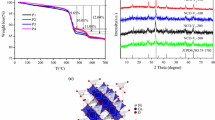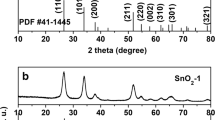Abstract
Zn3Mo2O9 with various morphologies were constructed using hydrothermal, solvothermal, and high-temperature solid-phase strategies and used as negative electrodes of lithium-ion batteries firstly. The Zn3Mo2O9 obtained by high-temperature solid-state method (ZMO-t) is constructed by lots of small nanosheets, which has relatively uniform size and small particles among three samples. The unique morphology is beneficial for electrolyte permeation and further promotes the migration rate of lithium ions. At various current densities, test results can illustrate that the ZMO-t exhibited the best electrochemical performance than those of Zn3Mo2O9 obtained by solvothermal method (ZMO-s) and hydrothermal way (ZMO-h) materials at the same rates. Based on these results, the Zn3Mo2O9 synthesized via high-temperature solid-state strategy has the potential to become a novel negative electrode for Li-ion batteries going forward.






Similar content being viewed by others
Data availability
The data is available upon request.
References
Liu H, Zhang X, He S, He D, Shang Y, Yu H (2022) Molten salts for rechargeable batteries. Mater Today 60:128–157
Li Q, Zhang G, Qu Y, Zheng Z, Wang J, Zhu M, Duan L (2022) Capacity contribution mechanism of rGO for SnO2/rGO composite as anode of lithium-ion batteries. Chin J Mech-En 35:63
Wei TT, Liu X, Yang SJ, Wang PF, Yi TF (2023) Regulating the electrochemical activity of Fe-Mn-Cu-based layer oxides as cathode materials for high-performance Na-ion battery. J Energy Chem 80:603–613
Kim H, Kim JC, Bianchini M, Seo DH, Rodriguez-Garcia J, Ceder G (2017) Recent progress and perspective in electrode materials for K-ion batteries. Adv Energy Mater 1702384
Hu J, Qu Y, Shi F, Wang J, He X, Liao S, Duan L (2022) Enhancing the kinetics of zinc ion deposition by catalytic ion in polymer electrolytes for advanced Zn-MnO2 batteries. Adv Funct Mater 32:202209463
Xu J, Cai X, Cai S, Shao Y, Hu C, Lu S, Ding S (2023) High-energy lithium-ion batteries: recent progress and a promising future in applications. Energy Environ Mater 0:e12450
Wei TT, Peng PP, Ji YR, Zhu YR, Yi TF, Xie Y (2022) Rational construction and decoration of Li5Cr7Ti6O25@C nanofibers as stable lithium storage materials. J Energy Chem 71:400–410
Wang D, Du G, Han D, Su Q, Zhang M, Ding S, Xu B (2021) Electrochemical properties and reaction mechanism of ZnMoO4 nanotubes as anode materials for sodium-ion batteries. J Alloys Compd 859:157792
Yao X, Kong J, Zhou D, Zhao C, Zhou R, Lu X (2014) Mesoporous zinc ferrite/graphene composites: towards ultra-fast and stable anode for lithium-ion batteries. Carbon 79:493–499
Liang Z, Tu H, Kong Z, Yao X, Xu D, Liu S, Shao Y, Wu Y, Hao X (2022) Urchin like inverse spinel manganese doped NiCo2O4 microspheres as high performances anode for lithium-ion batteries. J Colloid Interface Sci 616:509–519
Lin Y, Zheng J, Du C, Li J, Zheng Y, Feng Q, Zhong K, Huang Z (2022) Nano-structured Zn3V3O8@N-doped graphene with high-rate and ultra-stable storage as anode of lithium-ion batteries. J Alloys Compd 912:165068
Zhang L, Zheng S, Wang L, Tang H, Xue H, Wang G, Pang H (2017) Fabrication of metal molybdate micro/nanomaterials for electrochemical energy storage. Small 13:1700917
Zhang K, He J, Shen R, Sun X, Ouyang Q, Chen Y, Gao Y, Ji W (2020) Synthesis and tunable nonlinear absorption properties of Zn3Mo2O9 nanosheet ceramic material. Opt Mater 99:109570
Li C, Wen W, Xiang H, Fang L, Sun Y (2018) Low temperature sintering and microwave dielectric properties of Zn3Mo2O9 ceramic. J Mater Sci: Mater Electron 29:1907–1913
Tang L, Dang Q, Tang Y, Xu Q, Zhu M, Han X, Liu P, Chen W (2023) Synthesis of fluoride-substituted layered perovskites ZnMoO4 with an enhanced photocatalytic activity. ACS Appl Mater Interfaces 15:43251–43258
Samimi F, Ghiyasiyan-Arani M, Salavati-Niasari M, Alwash SW (2023) A study of relative electrochemical hydrogen storage capacity of active materials based on Zn3Mo2O9/ZnO and Zn3Mo2O9/ZnMoO4. Int J Hydrogen Energy 48:10070–10080
Zhu Y, Zhong Y, Chen G, Deng X, Cai R, Li L, Shao Z (2016) A hierarchical Zn2Mo3O8 nanodots–porous carbon composite as a superior anode for lithium-ion batteries. Chem Commun 52:9402–9405
Fei J, Sun Q, Li J, Cui Y, Huang J, Hui W, Hu H (2017) Synthesis and electrochemical performance of α-ZnMoO4 nanoparticles as anode material for lithium ion batteries. Mater Lett 198:4–7
Zhang K, Kuang Q, Wu J, Wen N, Fan Q, Dong Y, Zhao Y (2022) Layered structural Zn2Mo3O8 as electrode material for aqueous zinc-ion batteries. Electrochim Acta 403:139629
Li J, Du K, Lai Y, Chen Y, Zhang Z (2017) ZnSb2O6: an advanced anode material for Li-ion batteries. J Mater Chem A 5:10843–10848
Wu D, Tian J, Xing Y, Jin X, Ni G (2021) Fabrication of Z-scheme ZnO/Bi2O4 heterojunction photocatalyst with superior photocatalytic nitrogen fixation under visible light irradiation. Solid State Sci 119:106709
Chen Y, Wang Y, Shen X, Cai R, Yang H, Xu K, Yuan A, Ji Z (2018) Cyanide-metal framework derived CoMoO4/Co3O4 hollow porous octahedrons as advanced anodes for high performance lithium ion batteries. J Mater Chem A 6:1048
Lu X, Liu H, Shi X, Zhang J (2022) A simple synthesis of Li3Fe(MoO4)3@C composite anode materials with high initial Coulombic efficiency and high capacity stability for lithium ion batteries. J Electroanal Chem 927:116998
Singh J, Lee S, Yadav P, Kim S, Kim J, Rai AK (2022) Mesoporous mulberry-like CoMoO4: a highly suitable anode material for sodium ion batteries over lithium ion batteries. ACS Appl Energy Mater 5:126–136
Chen Y, Ma L, Shen X, Qiu J, Lian J, Ji Z, Yuan A, Kong L (2023) In situ construction of Zn2Mo3O8/ZnO hierarchical nanosheets on graphene as advanced anode materials for lithium-ion batteries. Inorg Chem 62:6032–6046
Yao X, Xin X, Zhang Y, Wang J, Liu Z, Xu X (2012) Co3O4 nanowires as high capacity anode materials for lithium ion batteries. J Alloys Compd 521:95–100
Zhao C, Kong J, Yang L, Yao X, Phua SL, Lu X (2014) The dopamine–MoVI complexation-assisted large-scale aqueous synthesis of a single-layer MoS2/carbon sandwich structure for ultrafast, long-life lithium-ion batteries. Chem Commun 50:9672–9675
Han MC, Zhang JH, Cui P, Zhu YR, Yi TF (2020) Construction of spherical ZnTiO3/MWCNTs composites as anode material for high-performance Li-ion batteries. Sustain Mater Technol 25:e00207
Wan L, Shen J, Zhang Y, Li X (2017) Novel ZnMoO4/reduced graphene oxide hybrid as a high-performance anode material for lithium ion batteries. J Alloys Compd 708:713–721
Singh B, Tamta A, Chandra B, Kandpal ND, Jadaun SS, Panwar AK, Babu KV, Justin P, Rao HS, Sekhar KSKRC (2023) Structural, optical, electrical, and electrochemical properties of ZnMoO4 microspheres synthesized by the twin crystal method. Ceram Int 49:38047–38057
Ryu K, Lee MJ, Lee K, Lee SW (2023) ZnO-embedded expanded graphite composite anodes with controlled charge storage mechanism enabling operation of lithium-ion batteries at ultra-low temperatures. Energy Environ Mater 6:e12662
Chen Y, Zong W, Chen H, Li Z, Pang H, Yuan A, Yang H, Shen X (2021) Cyanide-metal framework derived porous MoO3-Fe2O3 hybrid micro-octahedrons as superior anode for lithium-ion batteries. Chem Eng J 426:130347
Xie Q, Lin L, Ma Y, Zeng D, Yang J, Huang J, Wang L, Peng DL (2017) Synthesis of ZnO-Cu-C yolk-shell hybrid microspheres with enhanced electrochemical properties for lithium ion battery anodes. Electrochim Acta 226:79–88
Peng Z, Zhang H, Ali I, Li J, Ding Y, Deng L, Han T, Zhu H, Zeng X, Cheng D, Cheng L, Liu J (2021) A rod-on-tube CoMoO4@hydrogel composite as lithium-ion battery anode with high capacity and stable rate-performance. J Alloys Compd 858:157648
Mu K, Tao Y, Peng Z, Hu G, Du K, Cao Y (2019) Surface architecture modification of high capacity Li1.2Ni0.2Mn0.6O2 with synergistic conductive polymers LiPPA and PPy for lithium ion batteries. Appl Surf Sci 495:143503
Wang X, Hao H, Liu J, Huang T, Yu A (2011) A novel method for preparation of macroposous lithium nickel manganese oxygen as cathode material for lithium ion batteries. Electrochim Acta 56:4065–4069
Almodóvar P, López ML, Ramírez-Castellanos J, Nappini S, Magnano E, González-Calbet JM, Díaz-Guerra C (2021) Synthesis, characterization and electrochemical assessment of hexagonal molybdenum trioxide (h-MoO3) micro-composites with graphite, graphene and graphene oxide or lithium ion batteries. Electrochim Acta 365:137355
Xie J, Tang F, Li H, Jiang W, Yang Z, Zhao D, Xu Y, Meng Y, Sun W, Jiang Z (2023) FeMoO4/N-doped porous carbon composites as anode material for high-performance lithium-ion batteries. J Electroanal Chem 943:117623
Niu H, Yang Q, Wang Q, Jing X, Zhu K, Ye K, Wang G, Cao D, Yan J (2020) Oxygen vacancies-enriched sub-7 nm cross-linked Bi2.88Fe5O12-x nanoparticles anchored MXene for electrochemical energy storage with high volumetric performances. Nano Energy 78:105360
Liu T, Li L, Liu B, Yao T, Wang H (2022) Polyvinylpyrrolidone-regulated synthesis of hollow manganese vanadium oxide microspheres as a high-performance anode for lithium-ion batteries. J Colloid Interface Sci 620:144–152
Yang J, Gao H, Men S, Shi Z, Lin Z, Kang X, Chen S (2018) CoSe2 Nanoparticles encapsulated by N-doped carbon framework intertwined with carbon nanotubes: high-performance dual-role anode materials for both Li-and Na-ion batteries. Adv Sci 5:1800763
Aiswarya PM, Narang S, Dawar R, Pathak DD, Mishra R (2024) Zn-Mo-O system: insights into the thermodynamic stability and applicability in lithium ion batteries. J Alloys Compd 971:172619
Kim HS, Cook JB, Lin H, Ko JS, Tolbert SH, Ozolins V, Dunn B (2017) Oxygen vacancies enhance pseudocapacitive charge storage properties of MoO3–x. Nat Mater 16:454–460
Camacho RAP, Tian R, Liu J, Zhou S, Resources WuA, Huang H (2021) Superior lithium-ion storage of V-doped MoO3 nanosheets via plasma evaporation. Electrochim Acta 394:139121
Funding
This work was financially supported by Natural Science Foundation of Anhui Provincial Education Department (No. 2023AH051085).
Author information
Authors and Affiliations
Contributions
Jian Liu: Conceptualization, Data curation, Writing - original draft. Fei-Long Li:Writing-original draft. Meng-Cheng Han: Methodology, Supervision. Wen-Jie Shao: Visualization. Xiao-Hui Le: Material synthesis.
Corresponding authors
Ethics declarations
Ethics approval
This article does not contain any studies with human participants or animals performed by any of the authors.
Competing interests
The authors declare no competing interests.
Additional information
Publisher's Note
Springer Nature remains neutral with regard to jurisdictional claims in published maps and institutional affiliations.
Rights and permissions
Springer Nature or its licensor (e.g. a society or other partner) holds exclusive rights to this article under a publishing agreement with the author(s) or other rightsholder(s); author self-archiving of the accepted manuscript version of this article is solely governed by the terms of such publishing agreement and applicable law.
About this article
Cite this article
Liu, J., Li, FL., Han, MC. et al. Exploration of the electrochemical properties for Zn3Mo2O9 with different morphologies as novel negative electrodes of Li-ion batteries. Ionics 30, 1983–1992 (2024). https://doi.org/10.1007/s11581-024-05409-4
Received:
Revised:
Accepted:
Published:
Issue Date:
DOI: https://doi.org/10.1007/s11581-024-05409-4




